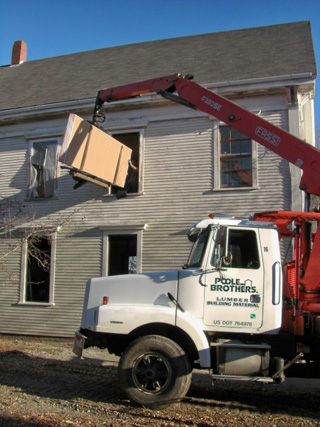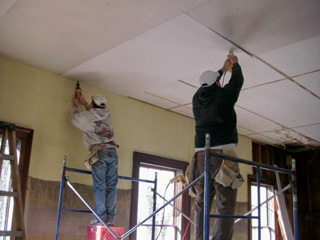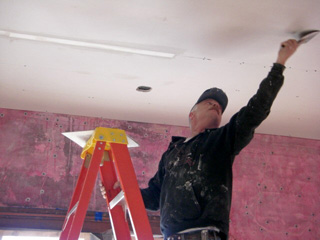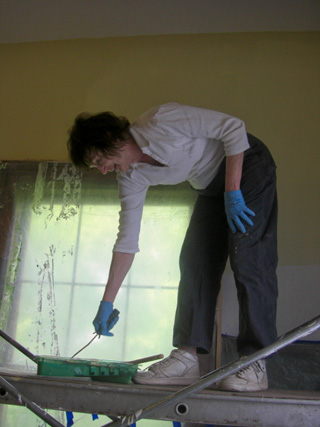Round Pond Schoolhouse Association
1426 State Route 32 Round Pond, ME 04564
1426 State Route 32 Round Pond, ME 04564

The original plaster walls were generally still present, though badly cracked all over and butchered in places. Nails, screws, shelving, cabinets and wiring holes damaged the appearance; wainscoting and chair rails were often pulled off. The lower floor had been painted 'battleship grey' both on the woodwork and some of the walls; where shelving was removed the original schoolhouse yellow was revealed.
The upper floor generally retained its yellow paint and walnut stained wood. However, the upper S.W. corner, where the fire escape and outhouse doors had been, was rotted by a roof leak and chewed by long occupying porcupines. (We shoveled up 6 beer cartons full of porcupine skat and quills from this, their dump area.) The timbers were all exposed in this corner and badly chewed. They were judged to be structurally adequate but needed to be buttressed for strength and to give surfaces for sheet-rock nailing. Wire screens were screwed at floor level between the inner and outer walls to baffle porcupine climbing. Volunteer labor took down the crumbling plaster and wood fragments in this area, cleaning it out in preparation for the sheet-rockers.

It was decided to salvage all plaster walls possible to retain the authentic wavy look, but the rebuilt partition walls and the ceilings would be sheet-rocked. Trey Walker and his crew came just before freezing weather to hang the panels, deferring mudding-in until the weather warmed in the spring.
Before he came, the upper stair well area was prepared for replastering and painting because the stairwell would be reopened in the winter; once the floor had been cut away, it would be extremely difficult to get up there to hang, mud, plaster and paint. This was the only area to be completed before the second winter.

Plaster wall preparation consisted of the following: surface sanding to remove dust and grease. Those areas that had badly peeling paint were thought perhaps to be covered with calcimite. These surfaces were deep sanded down to the plaster. Then plaster buttons were screwed in by the 100's, anchoring each crack line.
The walls were washed, then covered with 'Plaster Weld' bonding compound. (We were helped in this by the sheriff's crew as part of their winter work projects.) Plastering was in 3 layers of increasingly smooth grit, sanding between layers.

Patches of historic yellow paint were applied to the wall so that the Board could choose the closest tone to match the original. (We chose half-tinted 'Knightly Straw'.) Once again, California Paints offered to factory mix and sell at factory cost, both the primer and 2 coats of their top quality latex interior paint.